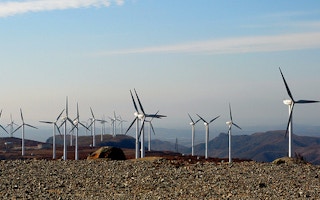Windpower alone could deliver 26 per cent of China’s projected electricity demand by 2030, according to new research.
And the nation with more turbines than any other country could make an even more efficient switch to renewable energy, not by putting the turbines where the wind is strongest, but where they would best suit the needs of the nation’s grid.
Electricity generation in China has grown by more than 150 per cent in the last decade, and China’s investment in coal means that years ago it became the biggest single emitter of greenhouse gases, even though emissions per head of population are still well below those in Europe or the US.
The nation has pledged to generate 20 per cent of all its energy – not just electricity – from sources other than fossil fuels by 2030. And a partnership of scientists from Massachusetts Institute of Technology (MIT) in the US and Tsinghua University in Beijing has worked out how it can be done.
“
Wind that is built in distant, resource-rich areas benefits from more favourable physical properties but suffers from existing constraints on the operation of the power system.
Valerie Karplus, director, Tsinghua-MIT China Energy and Climate Project
Projected demand
They report in Nature Energy that wind alone could generate 11.9 per cent of the nation’s projected energy demand – again, not just electricity – by 2030, at a cost of 0.6 yuan (US$0.09) per kilowatt hour.
The challenge is not just to build the turbines, but to find the best way to integrate them into the nation’s power system. And that might mean by-passing some of the windiest places in China.
“Wind that is built in distant, resource-rich areas benefits from more favourable physical properties but suffers from existing constraints on the operation of the power system,” says Valerie Karplus, MIT assistant professor of global economics and management, who directs the Tsinghua-MIT China Energy and Climate Project.
Studies like this present governments with options: in the US, for instance, at least two teams of researchers have calculated ways in which renewable energy could meet almost all or even all of America’s needs.
On paper, such projects can be made to work. But implementation requires more than just science; it also requires political action, economic incentive and time.
In 2015, wind power delivered just 3 per cent of China’s electricity demand, but the nation has invested heavily on research into renewable energy. The researchers found that – because of the costs of transmission and the difficulties of integration – turbines could be expected to exploit only a tenth of “resource-rich” areas, but that 10 per cent could do the trick.
Policy shift
The challenge is to make the capricious power from the winds of heaven fit flexibly into a grid powered by existing coal-fired stations. And this would mean a shift not just in technological investment but in national energy policy.
Coal-burning station managers are supposed to keep their operation profitable by continuing to deliver power, so what the scientists have shown is a range of possibilities. However, these would mean that a proportion of coal-fired stations would operate only when wind power could not meet demand.
In the Massachusetts-Tsinghua forecasts, greater flexibility could push wind power’s share of the nation’s total energy supply from nearly 12 per cent – the equivalent of almost 6 billion tonnes of coal that would not be shovelled into the furnaces – to 14 per cent by 2030. But that implies a shift in regulatory regimes.
“Existing policies prioritise sharing benefits equally among participants rather than facing strict price competition,” Professor Karplus says. “As electricity demand growth has slowed in recent years, the limited size of the pie means sharper conflicts between wind and coal.”

















